Ames W.F., Harrel E.M., Herod J.V. (editors). Differential Equations with Applications to Mathematical Physics
Подождите немного. Документ загружается.

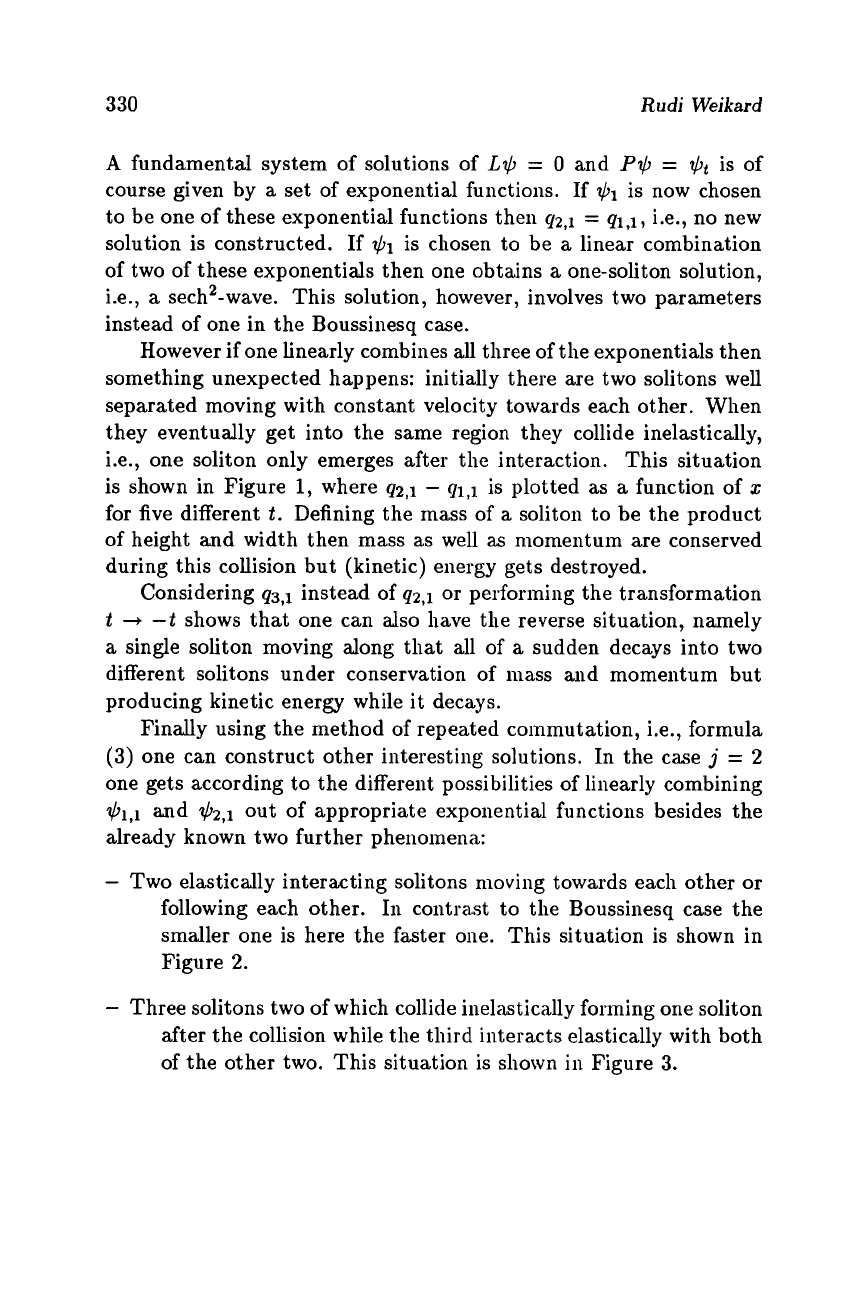
330
Rudi
Weikard
A
fundamental system of solutions of
L$
=
0
and
P$
=
$i
is of
course given by
a
set of exponential functions. If
$1
is now chosen
to be one of these exponential functions then
q2,l
=
ql,l,
i.e., no new
solution is constructed. If
$1
is chosen to be
a
linear combination
of two of these exponentials then one obtains
a
one-soliton solution,
i.e.,
a
sech2-wave. This solution, however, involves two parameters
instead of one in the Boussinesq case.
However if one linearly combines all three of the exponentials then
something unexpected happens: initially there are two solitons well
separated moving with constant velocity towards each other. When
they eventually get into the same region they collide inelastically,
i.e., one soliton only emerges after the interaction. This situation
is shown in Figure
1,
where
q2,1
-
q1,l
is plotted as
a
function of
z
for five different
t.
Defining the mass of
a
soliton to be the product
of height and width then mass as well
as
momentum are conserved
during this collision but (kinetic) energy gets destroyed.
Considering
q3,1
instead of
q2,1
or
performing the transformation
t
+
-t
shows that one can also have the reverse situation, namely
a
single soliton moving along that all
of
a
sudden decays into two
different solitons under conservation of mass and momentum but
producing kinetic energy while it decays.
Finally using the method of repeated commutation, i.e., formula
(3)
one can construct other interesting solutions. In the case
j
=
2
one gets according to the different possibilities of linearly combining
$1~
and
$2~
out of appropriate exponential functions besides the
already known two further phenomena:
-
Two elastically interacting solitons moving towards each other
or
following each other. In contrast to the Boussinesq case the
smaller one is here the faster one. This situation is shown in
Figure
2.
-
Three solitons two of which collide inelastically forming one soliton
after the collision while the third interacts elastically with both
of the other two. This situation is shown in Figure
3.
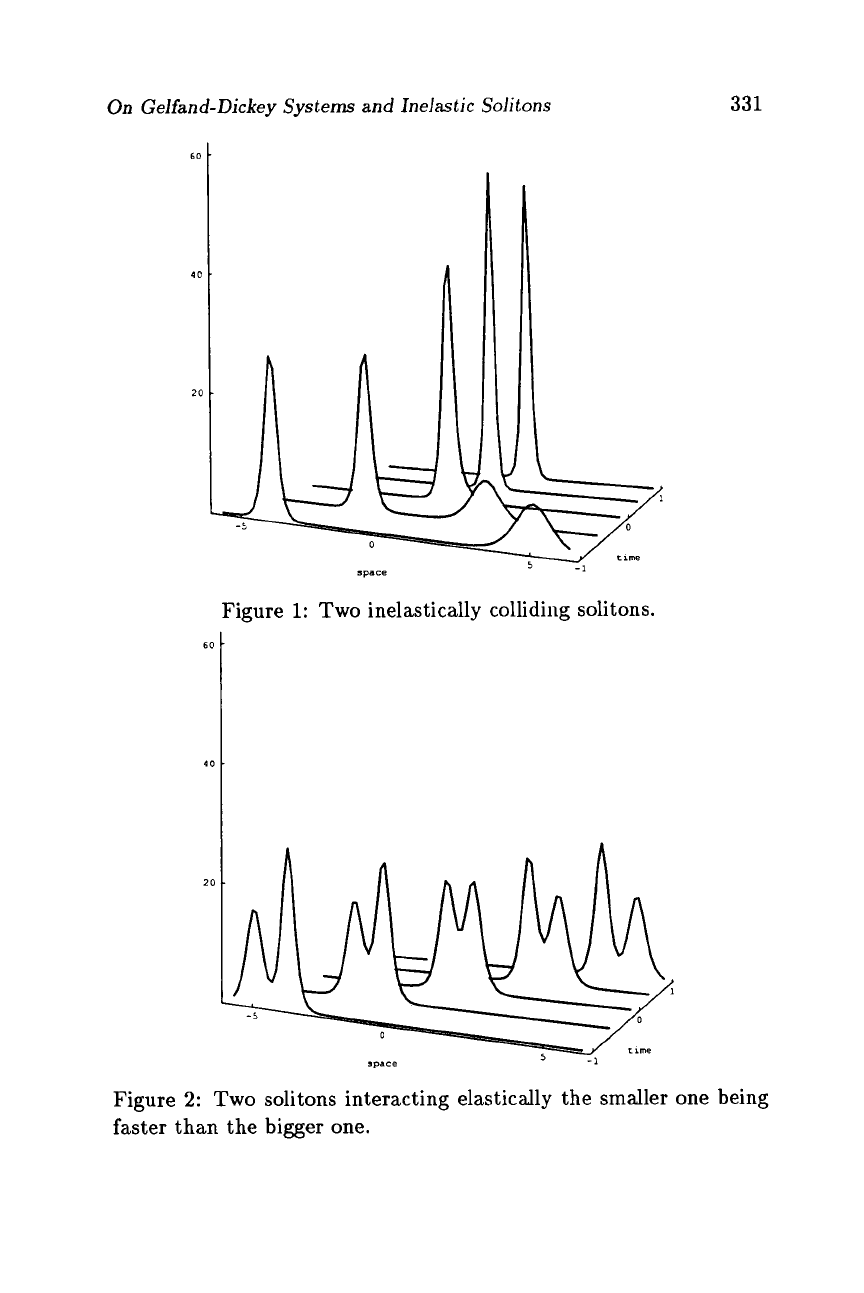
On Gelfand-Dickey
Systems
and Inelastic
Solitons
60
40
331
.
-1
space
Figure
1:
Two
inelastically colliding solitons.
Figure
2:
Two
solitons interacting elastically the smaller one being
faster than the bigger one.
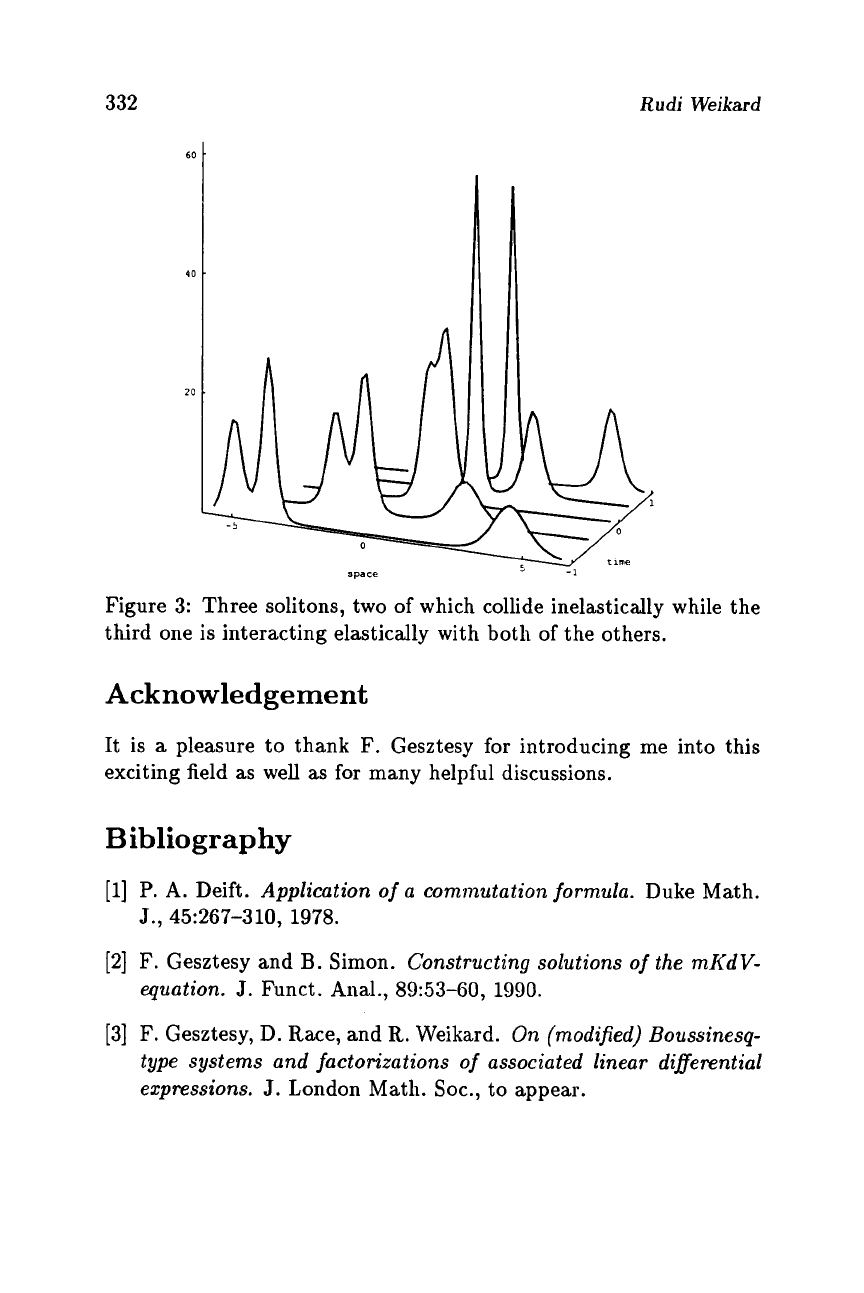
332
Rudi
Weikard
Figure
3:
Three solitons, two of which collide inelastically while the
third one is interacting elastically with both of the others.
Acknowledgement
It
is
a
pleasure to thank
F.
Gesztesy
for
introducing me into this
exciting field as well as
for
many helpful discussions.
Bibliography
[l]
P.
A. Deift.
Application
of
a
commutation formula.
Duke Math.
J.,
45:267-310,
1978.
[2]
F.
Gesztesy and
B.
Simon.
Constructing solutions
of
the mKdV-
equation.
J.
Funct. Anal.,
89:53-GO,
1990.
[3]
F.
Gesztesy, D. Race, and R. Weikard.
On
(modified) Boussinesq-
type systems and factorizations
of
associated linear diflerential
expressions.
J.
London Math. SOC., to appear.
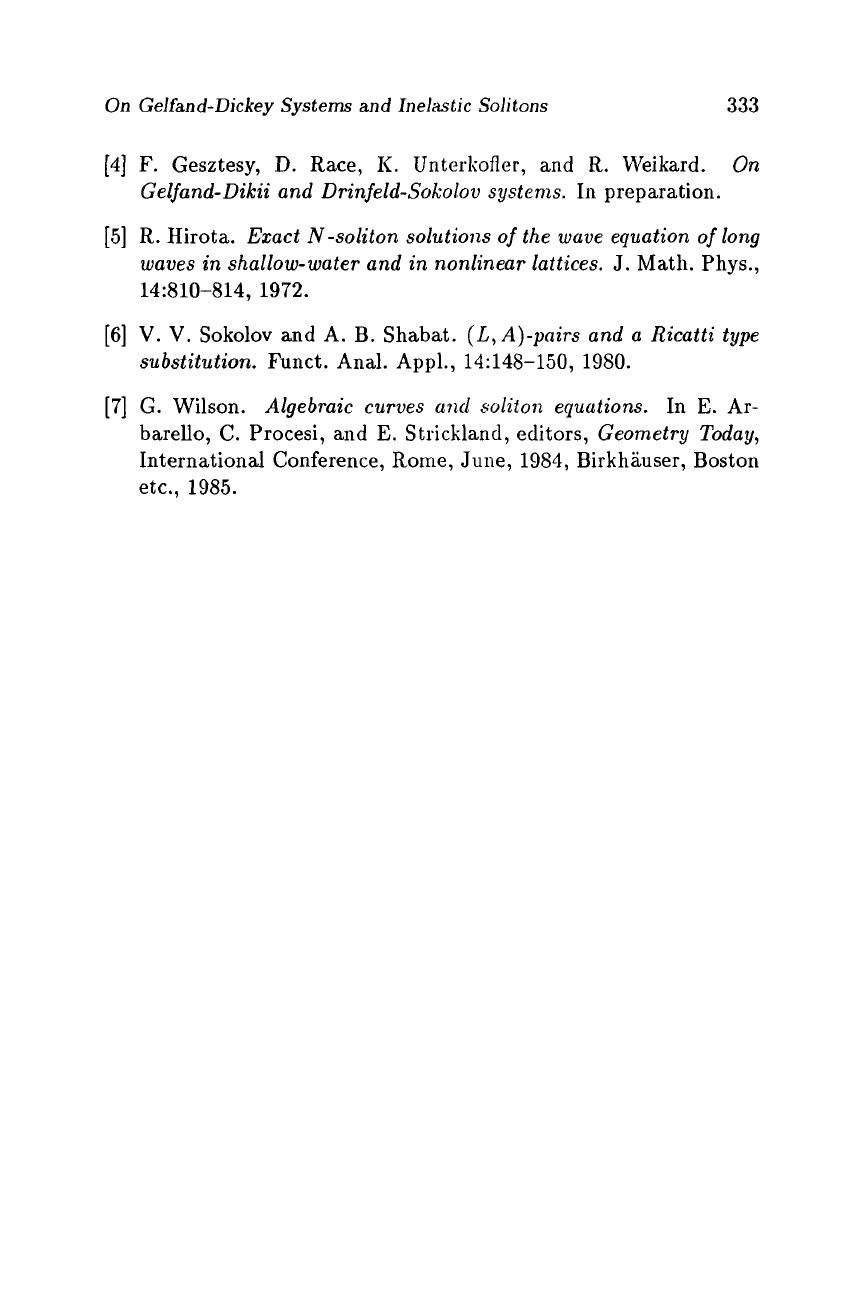
On Gelfand-Dickey
Systems
and Inelastic
Solitons
333
[4]
F.
Gesztesy,
D.
Race,
I<.
Unterkofler, and
R.
Weikard.
On
Gelfand- Dikii and Drinfeld-Sokolov systems.
In preparation.
[5]
R.
Hirota.
Exact N-soliton solutions
of
the wuve equation
of
long
waves
in
shallow-water and
in
nonlinear lattices.
J.
Math. Phys.,
14:8 10-814, 1972.
[6]
V.
V.
Sokolov
and A. B. Shabat.
(L,A)-pairs
and
a
Ricatti type
substitution.
Funct. Anal. Appl.,
143148-150,
1980.
[7]
G.
Wilson.
Algebraic curves
and
soliton equutions.
In
E.
Ar-
barello,
c.
Procesi,
and
E.
Strickland, editors,
Geometry Today,
International Conference,
Rome,
June,
1984, Birkhauser, Boston
etc.,
1985.

This page intentionally left blank

Inertial Manifolds and
Stabilization
in
Nonlinear
Elastic Systems with
Structural Damping
Yuncheng You
Department
of
Mathematics
University
of
South Florida
Tampa,
FL
33620
Abstract
Consider
a
nonlinear extensible flexural beam equation with
Balakrishnan-Ta,ylor damping and
a
structural damping, which serves
as
a
model of deflection and control
of
nonlinear aerospace structures.
To solve the “spillover” problem in stabilization of the relevant vi-
bration, which is significant in achieving system stability and per-
formance with controllers involving only finitely many modes, this
work provides
a
new approach by proving the existence of inertial
manifolds for the uncontrolled nonlinear equation. The results show
that, based on the information of inertial forms, the system is expo-
nentially stabiliza.ble by
a
linear
fini
te-dimensional feedback control
which is robust with respect to the uncertainty
of
parameters.
1
Introduction
The objective
of
this paper is to study the following initial-boundary
value problem of
a
nonlinear beam equation, cf. Bass and Zes
(1991),
Dinerentid Equations
with
Applications to Matheniatical
Copyright
@
1993
by
Academic
Press,
Inc.
All rights
of
reproduction in any
form
reserved.
Physics
ISBN
0-12-056740-7
335
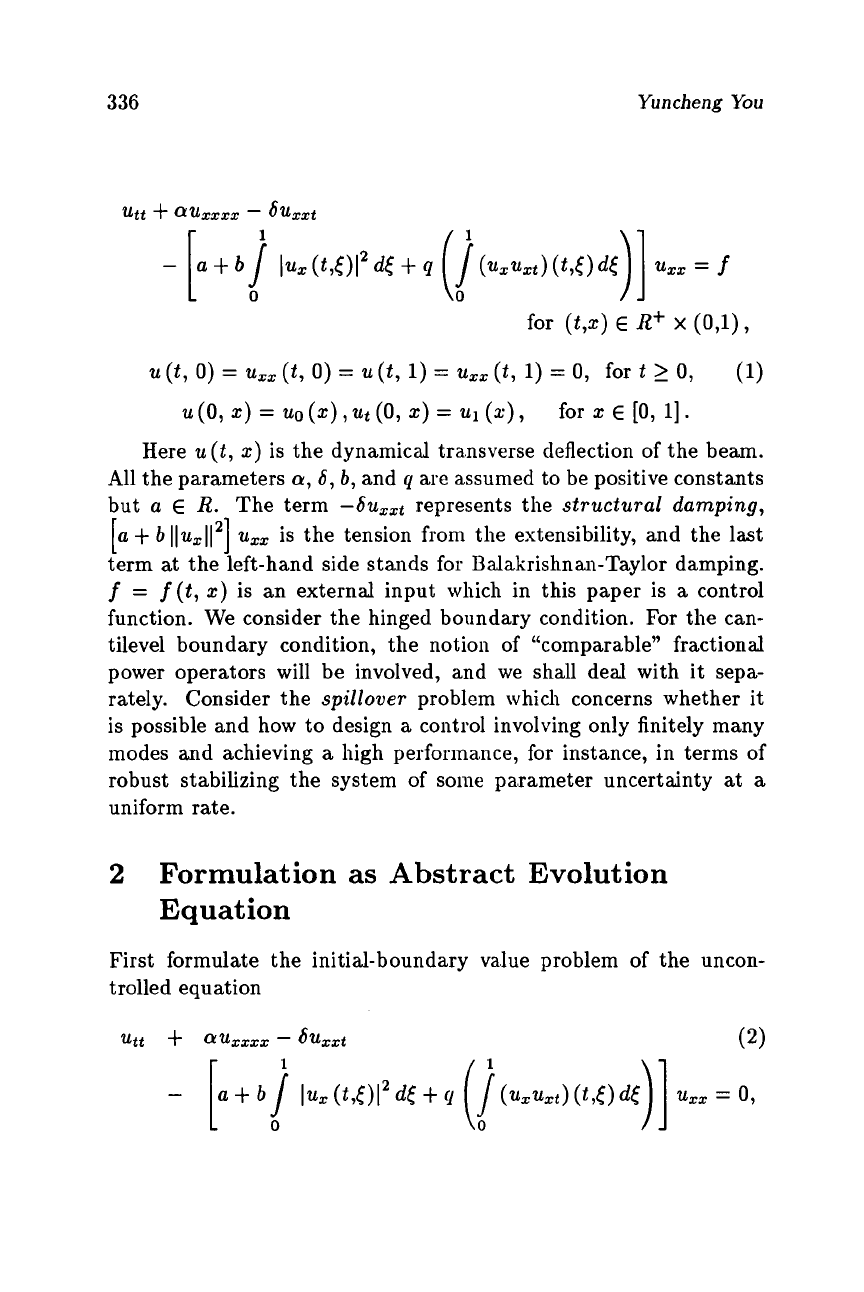
336
Yuncheng
You
for
(t,~)
E
R+
x
(O,1),
u
(t,
0)
=
u,,
(t,
0)
=
u
(t,
1)
=
u,,
(t,
1)
=
0,
for t
2
0,
for
5
E
[O,
11.
(1)
u
(0,
z)
=
uo
(z)
,
ut
(0,
x)
=
u1(x)
,
Here
u(t,
z)
is the dynamical tra.nsverse deflection of the beam.
All the parameters
a,
6,
b,
and
y
are assumed to be positive constants
but
u
E
R.
The term -6uZct represents the
structurd
dumping,
[u
+
b
11~,11~]
u,,
is the tension from the extensibility, and the last
term at the left-hand side stands
for
Balakrishnan-Taylor damping.
f
=
f
(t,
z)
is an external input which in this paper
is
a
control
function. We consider the hinged boundary condition. For the can-
tilevel boundary condition, the notion of “comparable” fractional
power operators will be involved, and we shall deal with it sepa-
rately. Consider the
spillover
problem which concerns whether it
is possible and how to design
a
control involving only finitely many
modes and achieving
a
high perforimnce, for instance, in terms of
robust stabilizing the system
of
some
prameter uncertainty at
a
uniform rate.
2
Formulation
as
Abstract Evolution
Equation
First formulate the initial-boundary value problem of the uncon-
trolled equation
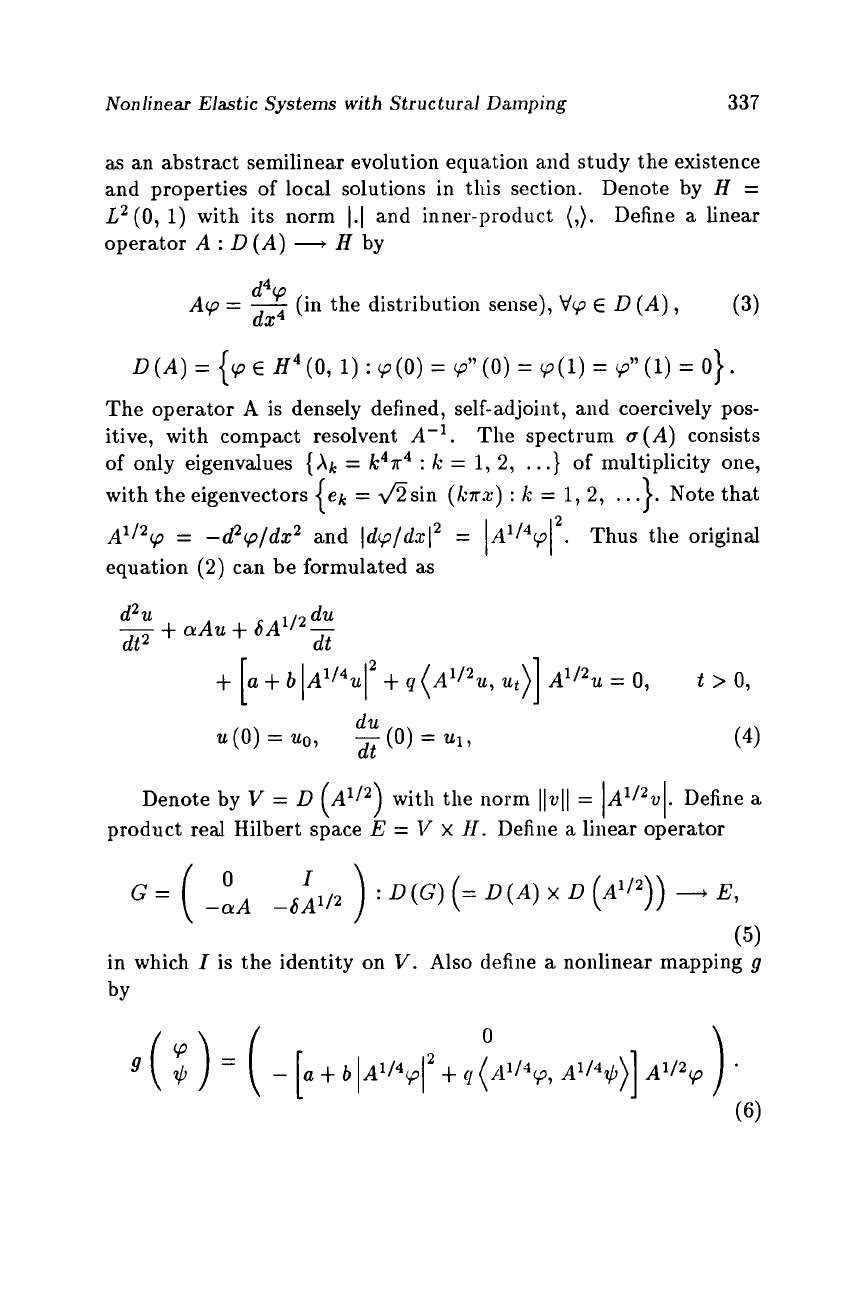
Nonlinear Elastic Systems with Structural
Darnping
337
as an abstract semilinear evolution equation and study the existence
and properties of local solutions in this section. Denote by
H
=
L2(0,
1)
with its norm
1.1
and inner-product
(,).
Define
a
linear
operator
A
:
D
(A)
-
H
by
d4Y7
A9
=
-
(in the distribution sense),
Vy
E
D
(A),
(3)
dx4
D(A)=
{~EH~(o,
i):~(~)=~~~(o)=~(i)=~~'(i)=o).
The operator
A
is densely defined, self-a.djoint, and coercively pos-
itive, with compact resolvent
A-'.
The spectrum
u
(A)
consists
of only eigenvalues
{
Xk
=
k47r4
:
b
=
1,
2,
.
.
.}
of multiplicity one,
with the eigenvectors
{ek
=
asin
(knx)
:
k
=
1,2,
. .
.}.
Note that
A112y
=
-d2v/dx2
and
Idy/dzI2
=
IA'/4p12. Thus the original
equation
(2)
can be formulated as
d2u du
-
+
aAu
+
6A112-
dt2 dt
+
[a
+
b
IA1/4~12
+
q
(A'12u,
u,)]
A112u
=
0,
t
>
0,
(4)
dU
u(0)
=
uo,
(0)
=
211,
Denote by
V
=
D
(All2)
with the norm
llvll
=
IA'/2~I.
Define
a
product real Hilbert space
E
=
V
x
II.
Define
a
linear operator
in which
I
is
the identity on
V.
Also
define
a
nonlinear mapping
g
by

338
Yuncheng
You
Then the equation
(4)
can be forumlated as
a
first-order evolution
equation:
or,
let
w
(t)
=
(
[i;
)
and
ZOO
=
(
:z
)
,
(
7)
d
dt
-zo=Gzo+~(zo),
t20,
WOE
E.
It can be shown that the operator
-G
is sectorial,
G
generates
an analytic semigroup of contraction, denoted by
{T
(t)
,
t
2
0},
and
G
has compact resolvent. Denote by
E'
=
D
((-G)'12)
and
E2
=
D(A)
x
D
(All2)
with the graph norms. The nonlinear mapping
g
:
E
-
E
(resp.
g
:
El
-
E')
is locally Lipschitz continuous and
maps any bounded set of
E
to
a
bounded set
of
E
(resp.
for
El).
The proof of the following existence and regularity of local solutions
is omitted.
Lemma
1
For
any
ZOO
E
E,
there is
u
T
=
T
(ZOO)
>
0
such that the
mild solution
of
the equation
(7)
with
the
iizitiul condition
w
(0)
=
wo
exists uniquely
for
t
E
[o,T],
and
tu
E
C
([o,T]
;
E)
n
C'
((0,~)
;
E)
n
C
((0,~);
E2).
If
wo
E
E2,
then this mild solution is
a
classical
solution
of
(7)
for
t
E
[O,r].
3
Dissipation
of
the Semiflow
In this section we will prove simultaneously the global existence of
mild solutions of the equation
(7)
and the dissipation property of the
generated semiflow in terms of the existence
of
absorbing sets in
E
and in
El.
As
a
result, there exists
a.
globd attractor in
E
and in
E'
respectively.
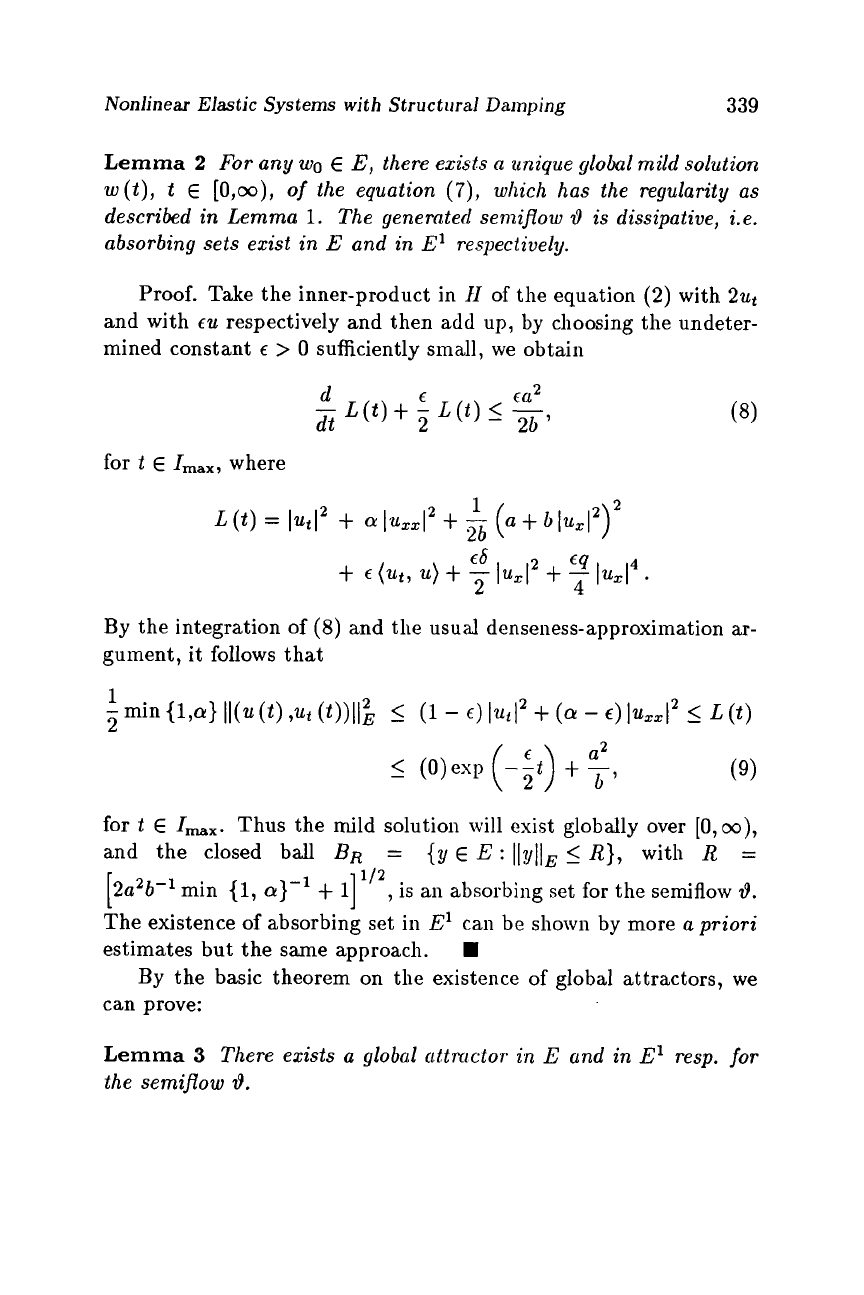
Nonlinear Elastic Systems with Structural
Damping
339
Lemma
2
For
any
wo
E
El
there exists
a
unique
global
mild solution
w(t),
t
E
[0,oo),
of
the equation
(7),
which
has
the regularity as
described
in
Lemma
1.
The generated semiflow
6
is dissipative, i.e.
absorbing sets exist
in
E
and
in
E'
respectively.
Proof.
Take the inner-product in
I1
of
the equation (2) with 2ut
and with
EU
respectively and then add up, by choosing the undeter-
mined constant
E
>
0
sufficiently small, we obtain
for
t
E
I,,,,
where
By
the integration
of
(8)
and the usual denseness-approximation ar-
gument, it follows that
1
-
min
{l,a}
II(u(t)
,ut
(t))lli
I
(1
-
€1
l.l~t1~
+
(a
-
6)
Iuzz12
5
L
(t)
2
for
t
E
I-,.
Thus the mild solution will exist globally over
[O,oo),
and the closed ball
BR
=
{y
E
E:
llyllE
I
R},
with
R
=
[2a26-' min
(1,
a}-'
+
11
,
is
an
absorbing set
for
the semiflow
6.
The existence
of
absorbing set in
E'
can
be shown by more
a
priori
estimates but the same approach.
By the basic theorem on the existence
of
global attractors, we
can prove:
112
Lemma
3
There exists a gZobu.1 attmctor
in
E
and
in
El
resp.
for
the semiflow
6.
